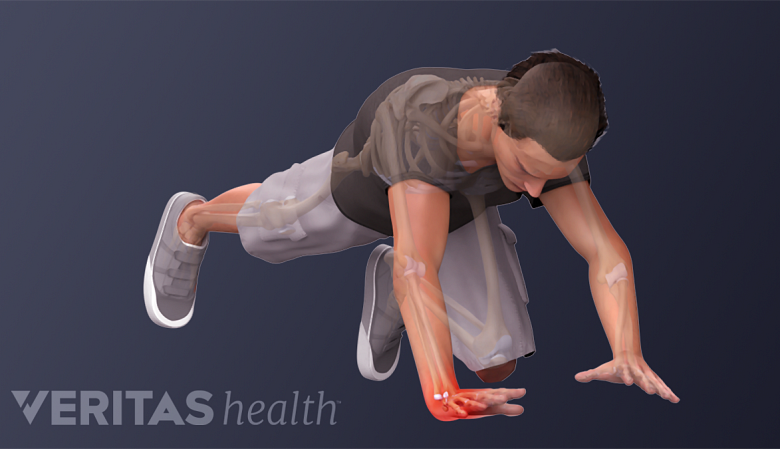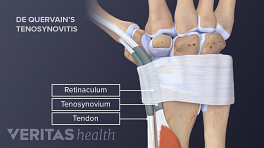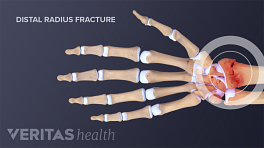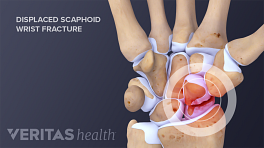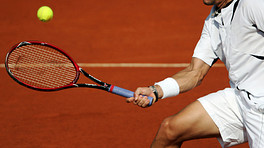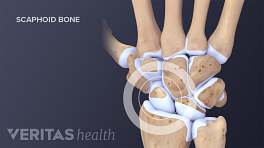Wrist sprains may be caused by bending, twisting, and/or other forceful impacts on the wrist from automobile accidents, falls, and/or playing sports. 1 Andersson JK. Treatment of scapholunate ligament injury: Current concepts. EFORT Open Rev. 2017;2(9):382-393. Sometimes, chronic, repeated trauma to the wrist’s ligaments may also cause sprains. People who are “loose jointed” are more prone to sprains and may take longer to heal them than people who are not loose jointed.
In This Article:
- What Is a Wrist Sprain?
- Symptoms of Wrist Sprain
- Risk Factors and Causes of Wrist Sprain
- Diagnosis of Wrist Sprain
- Treating Wrist Sprains
- Surgery for Wrist Sprain
Repetitive Use Is a Risk Factor for Wrist Sprain
Sports involving repetitive use of the wrist are common risk factors for wrist sprains. Repetitive stress, such as from crutch-walking, playing a new musical instrument, and/or over-use of the wrist (such as with fitness activities like push-ups), especially in the non-dominant arm are other risk factors for wrist ligament injury.
Causes of Wrist Sprain
Several factors may cause stretching and/or tearing of ligaments in the wrist. A few examples include:
- Falls. Supporting oneself from a fall by landing on an outstretched hand is a common reflex during loss of balance from slips or falls. This action is one of the most common causes of a wrist sprain.
1
Andersson JK. Treatment of scapholunate ligament injury: Current concepts. EFORT Open Rev. 2017;2(9):382-393.
When this type of injury occurs, the following factors determine the severity of the sprain:
- Position of the hand
- Amount of force on the hand
- Duration of time over which the force is extended on the hand
Wrist sprains from falls may occur in accidents, such as slipping over ice, snow, or wet surfaces, or falling from stairs or heights. Recreational activities, such as snowboarding, skiing, or skating may also cause wrist sprains during a fall.
- Sports. Injuries from playing certain sports can cause bending or twisting of a wrist, resulting in overstretching and/or tearing of one or more ligaments. A few examples of sports that may cause wrist sprains are:
- Racquet sports. Playing racquet sports, such as tennis may injure the wrist ligaments either by sudden force or by repeated trauma. A few examples of racquet actions that may sprain the wrist are:
- Repeated ground strokes (the first shot when the racquet hits the ball)
- Suddenly twisting or jerking the wrist when hitting the ball
- Constantly moving the hand while gripping the racquet’s handle
Similar injuries may also occur in sports involving the use of a bat, such as baseball or cricket.
- Hockey. Pressing down on the hockey stick and then releasing it with a flick of the wrists may injure the wrist ligaments.
- Weight lifting. Lifting heavy weights may sprain the wrist’s ligaments when the wrist bends beyond its normal range of motion. Wrist sprain in weight lifting may occur suddenly or over time due to repeated stress on the ligaments.
- Golf. Repeated impact and twisting of the wrist through swing may stress the wrist, in particular the triangular fibrocartilage complex (TFCC), causing partial or complete injuries.
- Boxing. Constantly hitting a heavy bag or opponent without adequate wrist support may cause high impact on the wrist’s ligaments.
See What to Do When a Wrist Injury Occurs
Wrist sprains from sports may be avoided by taking adequate precaution to protect the wrist with braces and other restraints. Warming up exercises help loosen ligaments and may help prevent wrist sprains.
- Racquet sports. Playing racquet sports, such as tennis may injure the wrist ligaments either by sudden force or by repeated trauma. A few examples of racquet actions that may sprain the wrist are:
- Motor vehicle accidents. Forceful bending of the wrist in a car or motor cycle accident may lead to ligament injury. Direct or indirect trauma from the deployment of an air bag may also injure the wrist’s ligaments in a car accident.
Medical evaluation and treatment of wrist sprains in the early stages is important to prevent progressive damage of the wrist joint, such as wrist osteoarthritis.
- 1 Andersson JK. Treatment of scapholunate ligament injury: Current concepts. EFORT Open Rev. 2017;2(9):382-393.
